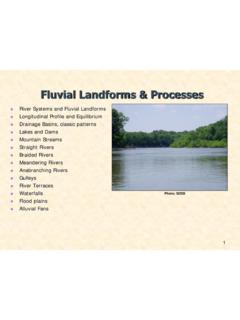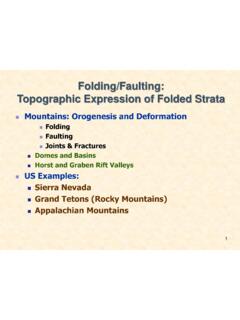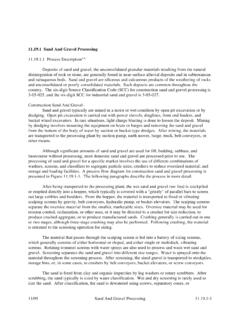Transcription of Chapter 4 Marine Sediments
1 2/23/20181 Chapter 4 Marine Sediments Marine Sediments are important because contain a record of Earth history & provide clues to understand it Marine organism distribution Ocean floor movements Ocean circulation patterns Climate change Global extinction events and provide many important resources Marine Sediments have origins from a variety of Overview2/23/20182 Paleoceanography study of how ocean, atmosphere, and land interactions have produced changes in ocean chemistry, circulation, biology, and Marine Sediments Marine Sediments provide clues to past environmental conditions. Cores of sediment collected from sea floor. Sediments Eroded particles Fragments of dust, dirt, other debris Suspension settling Sediments settle out of water and accumulate on ocean floor. Marine Sediments2/23/20183 Texture size and shape of particles Sediment origins Worn rocks Living organisms Minerals dissolved in water Outer space Sediments lithifyinto sedimentary rockMarine SedimentsClassification of Marine Sediments2/23/201847 Sediment Classification Particle Size (Grain Size) Location (where the grains are deposited) Source and Chemistry (color) One of the most important sediment properties Proportional to energy of transportation and deposition Classified by Wentworth scale of grain sizeGrain SizeTexture and Environment Texture indicates environmental energy High energy (strong wave action)
2 Larger particles Low energy smaller particles Larger particles closer to shore2/23/20185 Sediments Classified By Particle Size Measure of grain size uniformity Indicates selectivity of transportation process Well-sorted all same size particle Poorly sorted different size particles mixed togetherSorting2/23/2018611 Bluff ErosionOffshore Glacially Deposited sand Ridges, Relict Ebb ShoalsSorting of Littoral Sediments 2 mWave DominatedMixed EnergyGravelSandBarrier IslandCliff or Bluff Coast Neritic Shallow-water deposits Close to land -near continental margins & islands Dominantly lithogenous Typically deposited quickly Pelagic Deeper-water deposits -deep sea floor Finer-grained Sediments Deposited slowlySediment Distribution2/23/20187 Eroded rock fragments from land Also called terrigenous Reflect composition of rock from which derived Produced by weathering Breaking of rocks into smaller piecesLithogenousSediments Small particles eroded and transported Greatest quantity around continental marginsLithogenousSediments Reflect composition of rock from which derived Coarser Sediments closer to shore Finer Sediments farther from shore Mainly
3 Mineral quartz(SiO2)2/23/20188 LithogenousSediment Transport MechanismsCarried to ocean byStreams (a)Wind (b)Glaciers (c)Gravity (d) Beach deposits Mainly wave-deposited quartz-rich sands Continental shelf deposits Relict Sediments Turbiditedeposits Graded bedding Glacial deposits High-latitude continental shelf Currently forming by ice raftingNeritic LithogenousSediments2/23/20189 Fine-grained material Accumulates slowly on deep ocean floor Pelagic lithogenoussediment from Volcanic ash (volcanic eruptions) Wind-blown dust Fine-grained material transported by deep ocean currentsPelagic Deposits deep-sea floor Abyssal Clay At least 70% clay sized particles from continents Red clays from oxidized iron (Fe) Abundant if other Sediments absentHard remains of once-living organismsTwo major types: Macroscopic Visible to naked eye Shells, bones, teeth Microscopic Tiny shells or tests Biogenic oozeMainly algae and protozoansBiogenousSediment2/23/201810 BiogenousOozes sediment containing at least 30% biogenousmaterial.
4 Dominant on deep-ocean floor, 2 types of oozes: * Calcareous (CaCo3) oozes formed by organisms which contain calcium carbonate in their shells or skeletons dominantpelagic sediment(cocolithophorids, pteropods, foraminifera)* Siliceous (SiO2) oozesformed by organisms that contain silica in their shells. Diatoms are one type of organism whose remains contribute to siliceous oozes. The ocean isunder-saturated with respect to Si, so it can dissolve everywhere. (large contribution from photosynthetic organisms) Two most common chemical compounds are Calcium carbonate (CaCO3) Silica(SiO2or SiO2 nH2O)BiogenousSediment Composition Diatoms Photosynthetic algae Diatomaceous earth Radiolarians Protozoans Use external biogenoussediments 2/23/201811 Coccolithophores Also called nannoplankton Photosynthetic algae Coccoliths individual plates from dead organismCalcium Carbonate in Biogenic Sediments Foraminifera Protozoans Use external food Calcareous oozeCalcium Carbonate in Biogenic Sediments Rock chalk Lithifiedcoccolith-rich ooze White Cliffs of southern England (Dover)2/23/201812 Depends on three processes.
5 Productivity Number of organisms in surface water above ocean floor Destruction Skeletal remains (tests) dissolve in seawater at depth Dilution Deposition of other Sediments decreases percentage of biogenoussedimentsDistribution of BiogenousSediments Siliceous ooze Accumulates in areas of high productivity Silica tests no longer dissolved by seawater when buried by other testsPelagic Deposits2/23/201813 Dominated by lithogenoussediment, may contain biogenoussediment Carbonate Deposits Carbonate minerals containing CO3 Marine carbonates primarily limestone CaCO3 Most limestonescontain fossil shells Suggests biogenousorigin Ancient Marine carbonates constitute 25% of all sedimentary rocks on Earth. Neritic DepositsCarbonate Deposits Stromatolites Fine layers of carbonate Warm, shallow-ocean, high salinity Cyanobacteria Lived billions of years ago2/23/201814 Stromatolites Modern stromatoliteslive near Shark Bay, AustraliaCarbonate Deposits CCD Calcite compensation depth Depth where CaCO3readily dissolves Rate of supply = rate at which the shells dissolve Warm, shallow ocean saturated with calcium carbonate Cool, deep ocean undersaturatedwith calcium carbonateCalcareous Ooze2/23/201815 Calcareous Ooze and the CCD Scarce calcareous ooze below 5000 meters (16,400 feet) in modern ocean Ancient calcareous oozes at greater depths if moved by sea floor spreadingThe line shows the calcium carbonate (CaCO3) compensation depth (CCD).
6 At this depth, usually about 4,500 meters (14,800 feet about the height of some of the peaks in the Colorado Rocky Mountains, the rate at which calcareous Sediments accumulate equals the rate at which those Sediments (~4500 meters) depth where rate of dissolution of calcium carbonate is equals to its rate of accumulationCalcareous Oozes 2/23/201816 Sea Floor Spreading and Sediment AccumulationDistribution of Modern Calcium Carbonate Sediments2/23/201817 Minerals precipitatedirectly from seawater Manganese nodules Phosphates Carbonates Metal sulfides Small proportion of Marine Sediments Distributed in diverse environmentsHydrogenous Marine SedimentsOriginate from chemical reactions with water that occurinthe existing sediment. Hydrogenous Sediments are often found in the form of nodulescontaining manganese and iron oxides.)
7 Hydrogenous Sediments can be: Carbonates direct depositionPhosphorites abundant in continental shelf Salts by evaporation Evaporites-salts that precipitate as evaporation occurs. Evaporitesinclude many salts with economic importance. Evaporitescurrently form in the Gulf of California, the Red Sea, and the Persian GulfManganese nodules Mn, Fe, Cu, Ni, Co. These are found in abyssal seafloor and continental margins, around ocean ridges and seamounts (but at higher concentrations than those found on land). The Co (cobalt) content is of strategic importance to US (used in aircraft s manufacture).Hydrogenous2/23/201818 Fist-sized lumps of manganese, iron, and other metals Very slow accumulation rates Many commercial uses Unsure why they are not buried by seafloor sedimentsManganese NodulesPhosphates Phosphorus-bearing Occur beneath areas in surface ocean of very high biological productivity Economically useful as fertilizerCarbonates Aragonite and calcite OolitesPhosphates, Carbonates & Metal SulfidesMetal sulfides Contain.
8 Iron Nickel Copper Zinc Silver Other metals Associated with hydrothermal vents2/23/201819 Evaporites Minerals that form when seawater evaporates Restricted open ocean circulation High evaporation rates Halite (common table salt) and gypsumEvaporitesEvaporative Salts in Death Valley Macroscopic meteor debris Microscopic iron-nickel and silicate spherules (small globular masses) Tektites Space dust Overall, insignificant proportion of Marine sedimentsCosmogenousMarine Sediments2/23/201820 Neritic Sediments cover about of the sea floor. Pelagic Sediments cover about of the sea and Neritic Sediment DistributionDistribution controlled by Proximity to sources of lithogenoussediments Productivity of microscopic Marine organisms Depth of water Sea floor featuresPelagic and Neritic Sediment Distribution2/23/201821 Distribution of Sediments is determined by climate (temperature), environmental factors (nutrients, possible chemical reactions, activity of physical environment), supply, size and rate of accumulation.
9 Terrigenoussediments are deposited along the coastal boundaries 75% of Marine Sediments are from land coarser Sediments closer to coasts and finer Sediments at farther distances offshore Higher latitudes coarser Sediments ; lower latitudes finer Sediments At higher latitudes rafting by glaciers and ice contribute significant amounts of Sediments from land (coarse) Red clay (fine, pelagic lithogenous) found where there is not much of anything else deep ocean basins Calcareous are not found in deep-sea areas below 4500 m or where ocean primary productivity is low. Fund in warm, tropical latitudes, shallow areas (Caribbean), elevated ridges and seamounts Siliceous (photosynthesis) found below areas of very high biological productivity -abound in areas of N. Pacific and Antarctic Ocean: cold but nutrients and sun light good for about sediment distribution Worldwide Marine Sediment Thickness2/23/201822 Both mineral and organic resources sand and Gravel construction Phosphorite fertilizers Sulfur sulfuric acid for industry Coal energy Oil and Gas energy, transportation (20-25% of US production comes from offshore areas) MaganeseNodules Mn, Fe, Co, Cu, Ni Gas Hydrates energy in the future?
10 But note: Not easily accessible -Technological challenges, High costsResources Petroleum Ancient remains of microscopic organisms More than 95% of economic value of oceanic nonliving resources More than 30% of world s oil from offshore resources Future offshore exploration will be intense Potential for oil spillsEnergy Resources2/23/201823 Gas Hydrates Also called clathrates High pressures squeeze chilled water and gas into icelikesolid Methane hydrates most commonEnergy Resources Gas hydrates may be largest store of usable energy in organic carbon form. Rapidly decompose at surface pressures and temperatures Gas hydrates resemble ice but burn when lit May form on sea floor Sea floor methane supports rich community of organisms Most deposits on continental shelf Release of sea floor methane may alter global climate.











